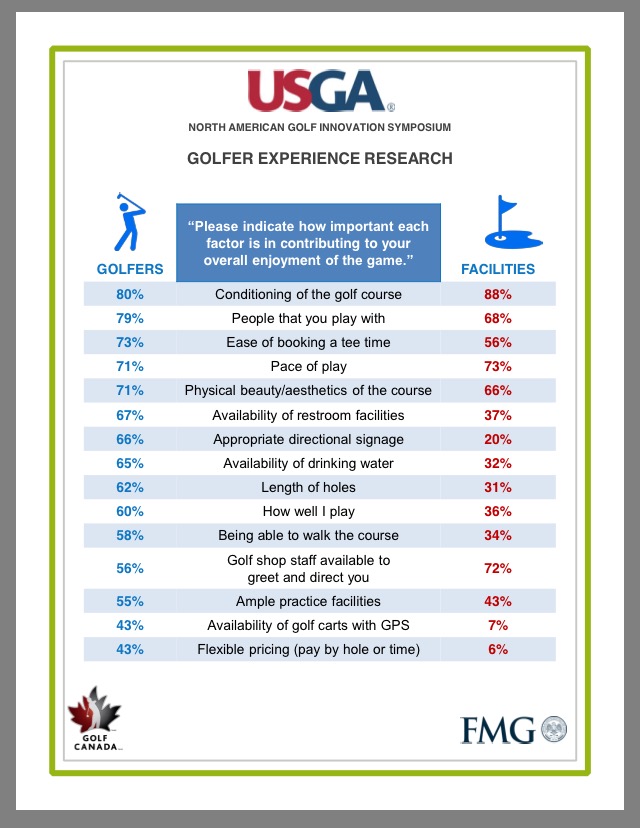
(photo by Steven Gibbons/Courtesy of USGA)
FEBRUARY 8, 2017
by Eric MacKenzie
When thinking of innovation in golf, often the first things that come to mind are the hot new driver on the market or the newest technology being applied to teaching or club fitting.
But after some of the game’s brightest minds assembled in British Columbia this week to discuss advancements in golf, it’s clear that there’s much more to the sport’s future than just new gadgets and equipment.
The USGA hosted its North American Golf Innovation Symposium in Vancouver on Monday and Tuesday in conjunction with Golf Canada and the Mexican Golf Federation. PGA of BC administration staff and several members attended the gathering and were among dozens of golf industry stakeholders who came from all over the continent, representing just about every facet of the game.
The wide variety of topics covered and the quantity of compelling presentations throughout the symposium makes it tough to summarize all of the fascinating takeaways from the event.
However, USGA senior managing director of public services Rand Jerris best summed up the way forward for golf with his definition of the “Holy Grail” – strategies that improve the playing experience while simultaneously optimizing use of resources.
To that end, Jerris issued a challenge to the entire industry to boost golfer satisfaction by 20 per cent while also reducing critical resource consumption by 25 per cent by 2025.
That may seem like a tall order, but the symposium offered up approaches on a number of fronts – how to serve players better, approaches to course maintenance, governance, technology and more – that will help put that goal within reach. For example, a demonstration of the USGA’s new Resource Management tool showed great potential for superintendents to identify the costs of maintaining specific sections of their course in great detail.
For PGA of BC members involved in facility management, Monday morning’s discussions surrounding the player experience would likely have been the most notable.

The results of surveying both players and golf facilities showed that there is a wide gap between what golfers want from their day on the course, and what courses think those players want. For example, details like the availability of washroom facilities, directional signage and access to drinking water were significantly more important to players than course operators thought. (Click the table to expand).
Beyond the obvious pace-of-play advantages, research presented Monday also showed that playing from a set of tees most appropriate to a player’s ability has a significant impact on how much they enjoyed their round. That’s particularly true if players are starting from distances that give them legitimate chances at reaching greens in regulation and achieving par on every hole.
Knowing that, success stories were shared from courses that have as many as 10 sets of tees listed on their scorecards, and also from facilities implementing tee-box suggestions based on carry distances at the driving range pre-round.
USGA president Mike Davis closed the symposium Tuesday by imagining future changes in the game’s perceptions – dismissing the notion that making courses longer, tougher and greener makes them better.
“For the last half-century in North America, there’s been this mindset that ‘Hard equals good,’ but what we really need to do is say: ‘An enjoyable golf experience equals good,’” said Davis. “This notion of continuing to make golf courses harder, longer, narrower, with higher rough and forced carries, lost balls … that probably isn’t going to add to that enjoyable experience.
“What’s wrong with a little tinge of brown in the grass?” Davis continued. “What’s wrong with a course where the balls bounce? A bouncier golf course is a far more interesting and strategic golf course and it’s not just for the elite player.
“We need to be open to what is in the best interest of the game and those that play the game.”
Thankfully, the USGA has archived its live-stream of the event on YouTube and has also highlighted some of the event’s key themes, so it’s not too late to get caught up on many of the concepts that were discussed in our own backyard this week. We encourage you to absorb as much of the information presented at the symposium and think about how these forward-looking strategies may apply to your own facilities as the industry looks to meet the challenge of increasing fun while limiting resources.
Eric MacKenzie is the Communications & Marketing Manager for the PGA of British Columbia.
